Catalog Ads for mid-end brands
October 14, 2024
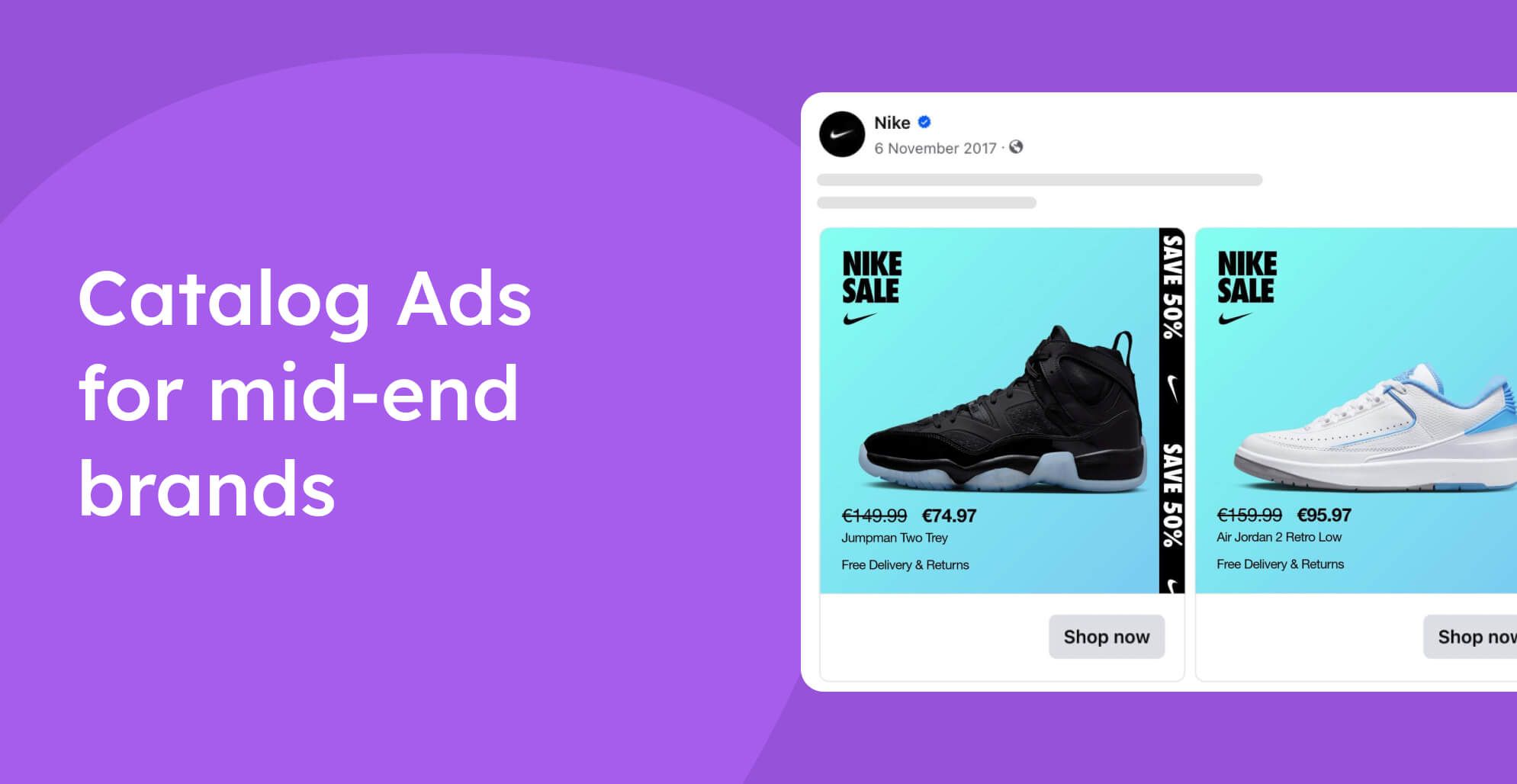
Mid-end brands’ customers look for value. Sure, price still carries a lot of weight. However, it’s not as straightforward as picking the cheapest product.
Catalog Ads allow mid-end brands to showcase their product range which is often broader than affordable shops. What’s more, they’re ideal for showcasing multiple related products to help promote cross-selling. This is key.
Mid-end brands’ typically operate on a smaller profit margin than luxury stores which means that their advertising efforts need to focus on improving the average order value.
To help you create Catalog Ads that communicate value to your target market, here’s data about which elements work well for mid-end brands. All the numbers shared show how Catalog Ads perform on average compared to those without that specific product field to give you a headstart on testing too.
Bookmark this page by pressing ctrl + D / cmd + D, or by clicking the star icon in your URL bar ⭐️.
Here you have the insights in a quick cheat sheet - click to get more details:
The most used product fields in Catalog Ads designs:
The moderately used product fields in Catalog Ads designs:
The rarely used product fields in Catalog Ads designs:
Showing Prices in your Catalog Ads
The more affordable your products are, the better performance you will typically see showing prices. When showing prices, affordable shops see a 60% improvement in return on ad spend (ROAS).
However, the same strategy yields only a 43% improvement in ROAS for mid-end shops. That said, the jump between mid-end and high-end/luxury shops is much smaller with the latter only enjoying a 35% improvement.
- Affordable shops see a +60% improvement in Return on Ad Spend when showing prices
- Mid-end shops see a +43% improvement in Return on Ad Spend when showing prices
- High-end/ Luxury shops see a +35% improvement in Return on Ad Spend when showing prices
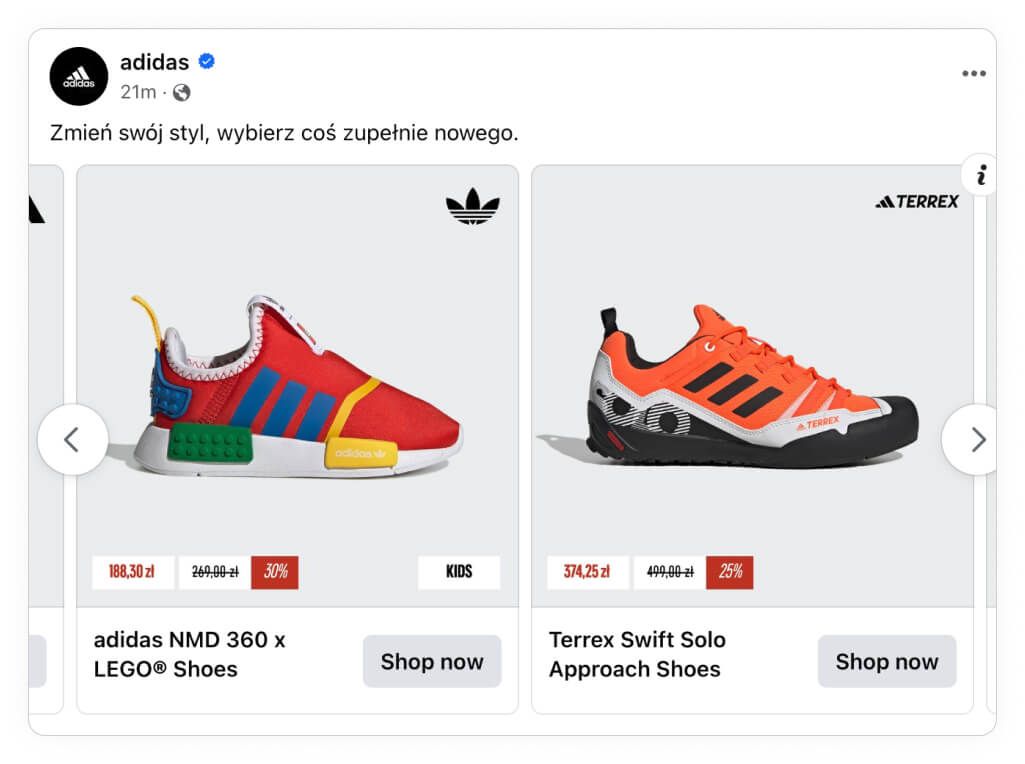
Even though the positive impact shrinks as your product prices increase, it’s still a good idea to display prices. It closely aligns with the buying behaviour and expectations of the value-conscious target market. After all, mid-end brands’ value proposition is typically rooted in accessible prices.
Here's how showing prices on average influence Catalog Ads:
Return On Ad Spend
+43%
Cost Per Purchase
-14%
Click Through Rate
-17%
Cost Per Click
+3%
Conversion Rate
+6%
Usage
55%
You can learn more about showing prices in your Catalog Ads right here.
Showing your Logo in Catalog Ads
Logos are typically connotated with quality which also helps to increase consumer confidence in purchasing mid-end products. Logos are often linked to the perceived quality of products, also in catalog ads.
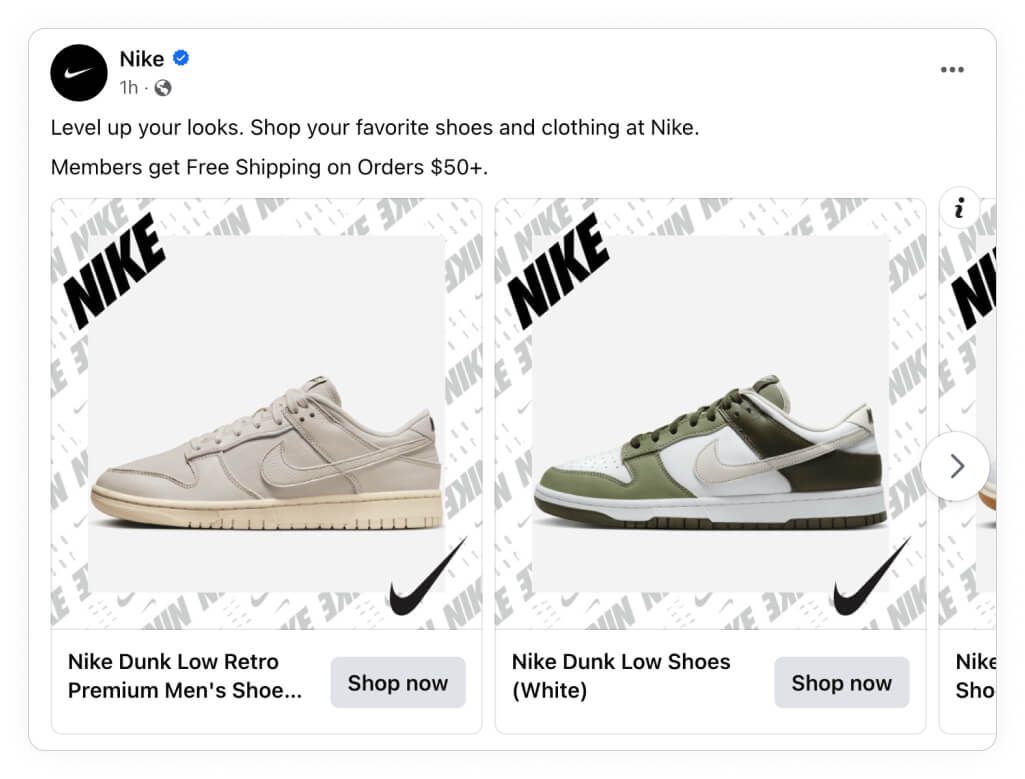
Here's how showing your logo on average influence Catalog Ads:
Return On Ad Spend
-6%
Cost Per Purchase
-23%
Click Through Rate
+10%
Cost Per Click
-20%
Conversion Rate
-20%
Usage
49%
The most impressive impact that including your logo in catalog ads design has is on the cost per purchase (CPP) and cost per click (CPC). For mid-end brands where shoppers may not yet have a deep brand loyalty, a logo can add that missing credibility and offer legitimacy to reassure shoppers.
For mid-end brands, it can elevate the perception of the product, making it seem more valuable and desirable. You’re often targeting consumers who are looking for something that feels upscale but not necessarily luxurious.
It can also communicate consistency. Along with quality, shoppers in this price bracket value reliability.
Showing On-sale designs in your Catalog Ads
Similarly to displaying prices, on-sale designs’ effectiveness decreases as your product prices increase. However, in this case, the differences are more significant.
Here’s how the ROAS for the following shop types changes when you incorporate a sale element:
- Affordable shops see a +97% improvement in Return on Ad Spend when showing on-sale designs
- Mid-end shops see a +48% improvement in Return on Ad Spend when showing on-sale designs
- High-end/ Luxury shops see a +25% improvement in Return on Ad Spend when showing on-sale designs
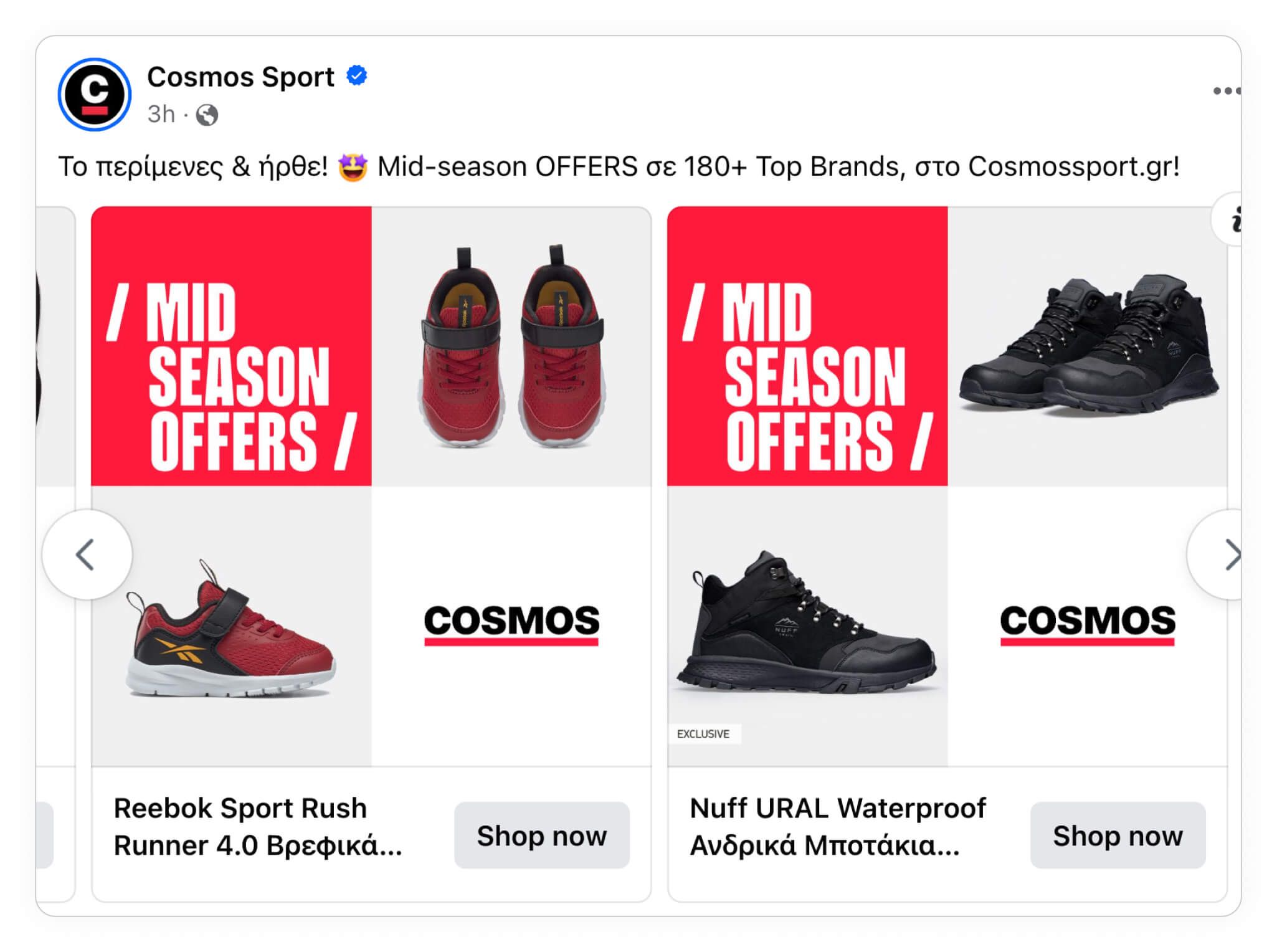
In addition to ROAS, mid-end brands also see positive results for click-through rate (CTR), cost per purchase, and cost per click.
Here's how showing on-sale designs influence Catalog Ads on average in these three and other key areas:
Return On Ad Spend
+48%
Cost Per Purchase
-24%
Click Through Rate
+10%
Cost Per Click
-24%
Conversion Rate
-18%
Usage
44%
These numbers show how Catalog Ads showing on-sale designs perform on average compared to Catalog Ads not showing on-sale designs.
Remember that these are average numbers. For some brands, on-sale designs perform better, and for other brands, on-sale designs perform worse.
Considering these insights, it’s a smart move for mid-end brands that need to appeal to their target markets that balance price against value. It fits in with the image associated with a mid-end brand as these designs help to display products in a way that feels exciting, without coming across as cheap or desperate.
Plus, on-sale designs typically use bold colors and fonts which encourage action, as seen in the uptick in clicks.
You can learn more about showing on-sale designs during campaigns in your Catalog Ads right here and see a lot of sales and campaign Catalog Ad examples here.
Showing Product Names in your Catalog Ads
This advertising strategy has similar impacts than that of incorporating your logo. However, unlike logos, product names also improve your ROAS.
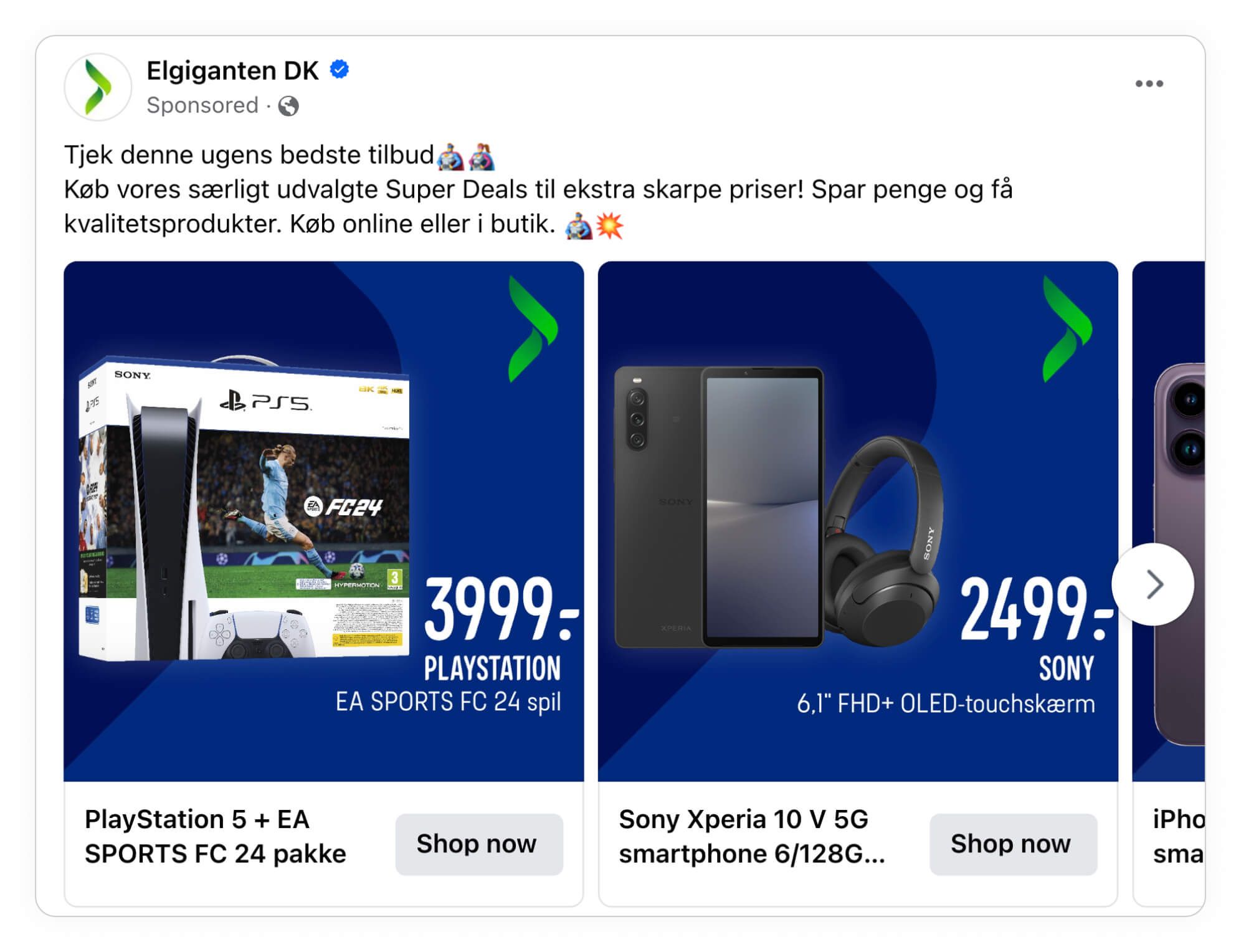
Here's how showing product names on average influence Catalog Ads:
Return On Ad Spend
+14%
Cost Per Purchase
-22%
Click Through Rate
+7%
Cost Per Click
-16%
Conversion Rate
-4%
Usage
41%
These numbers show how Catalog Ads showing product names perform on average compared to Catalog Ads not showing product names.
Remember that these are average numbers. For some brands, product names perform better, and for other brands, product names perform worse.
Consumers who shop from mid-end brands often compare options before purchasing. Including a product name makes it easier to find reviews (and the actual product again when they’re ready to purchase).
Product names can also help mid-end brands with their positioning. A carefully chosen product name can communicate sophistication, quality, and affordability at the same time.
Showing Original prices in your Catalog Ad
The original price is the regular price of a product before any discount or promotion. Showing it alongside the new, lower price highlights the savings, typically it creates a sense of urgency, and encourages quicker purchase decisions by making the value of the deal clear.
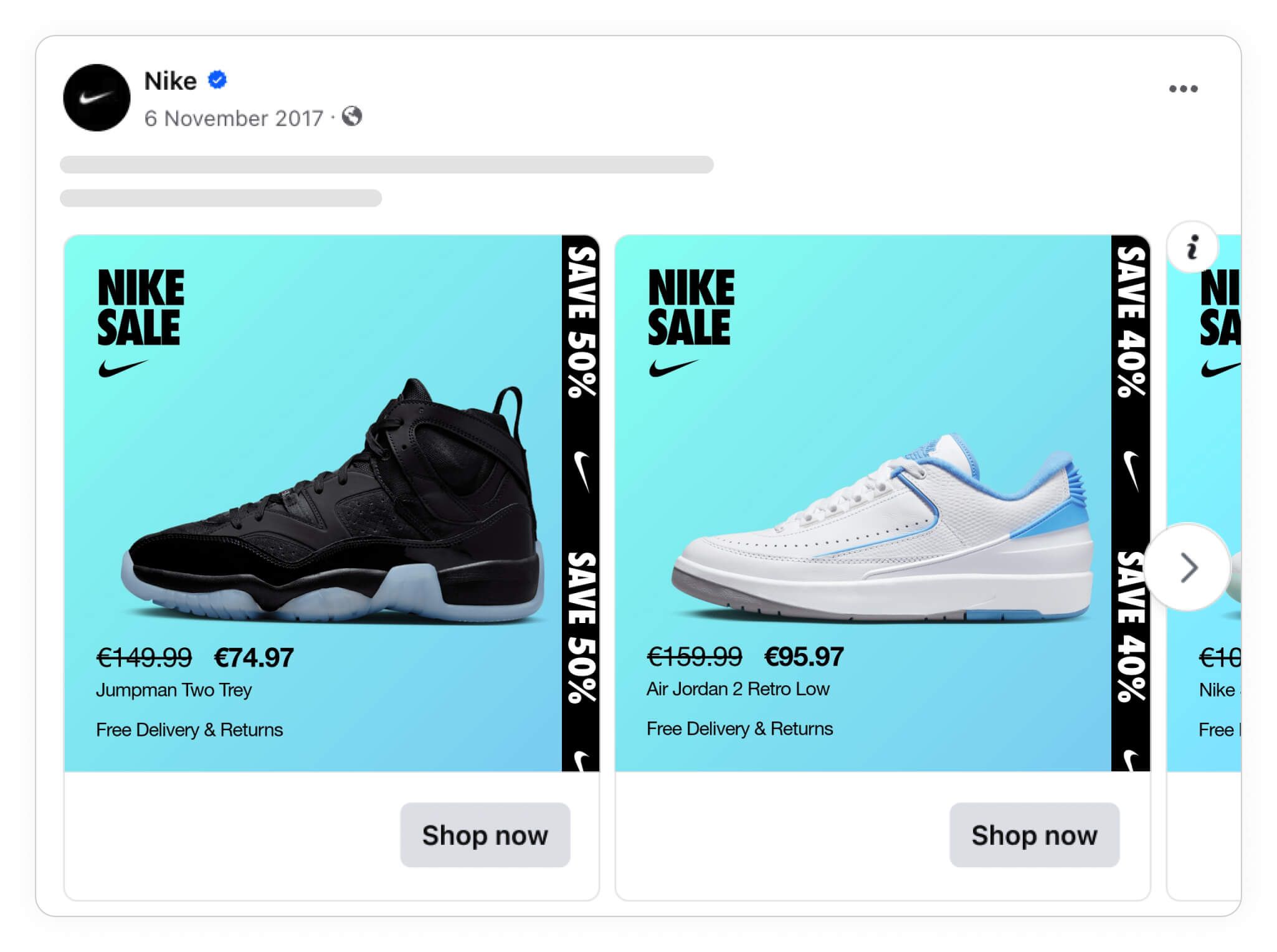
Here's how showing original prices on average influence Catalog Ads performance for mid-end brands:
Return On Ad Spend
+9%
Cost Per Purchase
-18%
Click Through Rate
+1%
Cost Per Click
-24%
Conversion Rate
-33%
Usage
26%
These numbers show how Catalog Ads showing original prices perform on average compared to Catalog Ads not showing original prices.
Remember that these are average numbers. For some brands, original prices perform better, and for other brands, original prices perform worse.
As it creates mixed results, you’ll need to use your specific campaign objectives to decide whether it will be a good strategy. If your goal is to lower your CPC, then yes.
If you’re more concerned about conversion, rather skip showing the original price. This is particularly true if the original price is too inflated, because it can make the discount look less legitimate (or even deceptive).
Customers may wonder if the product is really worth the original price, undermining the perceived value. After all, mid-end brands typically succeed by offering great value rather than steep discounts.
Showing additional images in your Catalog Ads
The benefit of using extra images is that they can help mid-end brands to boost the perception of value. That’s because varied images can make the product feel more thoughtfully presented and premium.
Does it also reflect on performance?
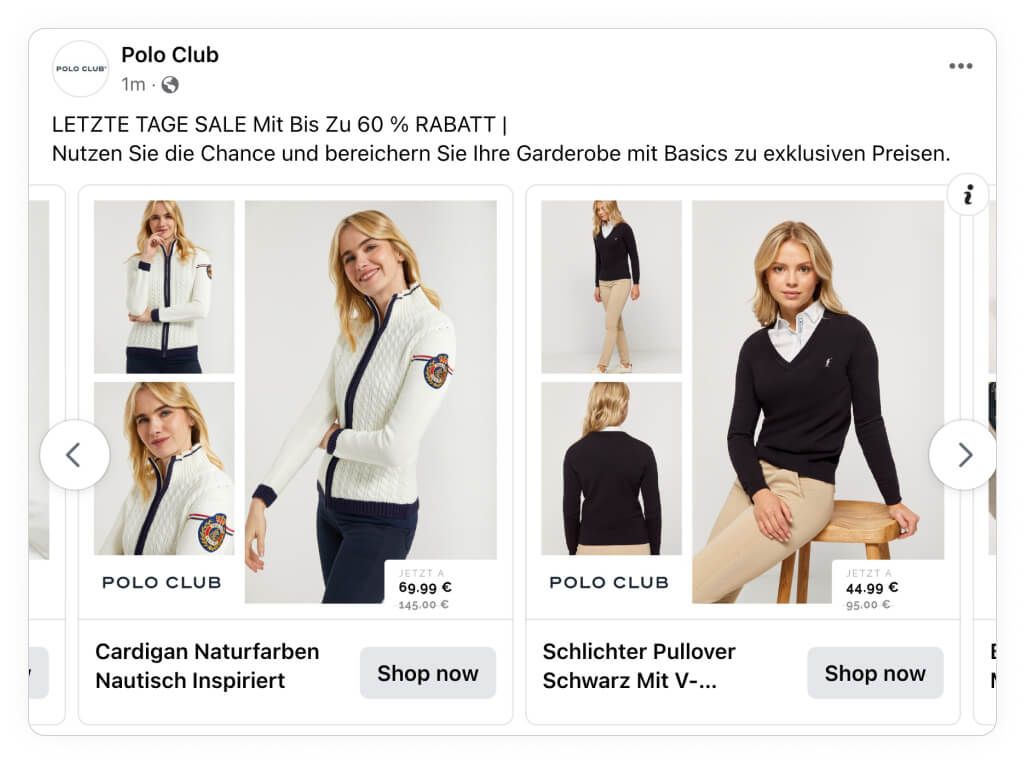
As the following data shows, including extra images in your catalog ads design generates marginal improvements - and that only in two areas - for mid-end brands
Here's how showing additional images on average influence Catalog Ads:
Return On Ad Spend
-4%
Cost Per Purchase
+0%
Click Through Rate
+5%
Cost Per Click
-5%
Conversion Rate
-3%
Usage
25%
These numbers show how Catalog Ads showing additional images perform on average compared to Catalog Ads not showing additional images.
Remember that these are average numbers. For some brands, additional images perform better, and for other brands, additional images perform worse.
Considering that both your ROAS and conversion rate will be impacted negatively, you’ll need to think carefully if the 5% decrease in CPC and CTR will be worth it.
It can help consumers browsing in this price range to see more product details and visualise how the product will fit into their life, helping them to balance quality and price.
That said, if it’s not done strategically, it can backfire. It can make the layout feel cluttered, which can explain the decrease in conversion.
Showing Savings and Discounts in your Catalog Ads
The more affordable prices you have, the better savings and discounts typically perform in your Catalog Ads. In fact, our data reveals that mid-end shops can see an improvement in ROAS of as much as 73% when they show savings and discounts.
While it’s not close to affordable shops’ 115% improvement, it’s nearly triple the ROAS improvement that luxury stores can expect. High-end brands need to settle with an increase of only 24%.
The more affordable prices you have, the better savings and discounts typically perform in your Catalog Ads.
- Affordable shops see a +115% improvement in Return on Ad Spend when showing savings and discounts
- Mid-end shops see a +73% improvement in Return on Ad Spend when showing savings and discounts
- High-end/ Luxury shops see a +24% improvement in Return on Ad Spend when showing savings and discounts
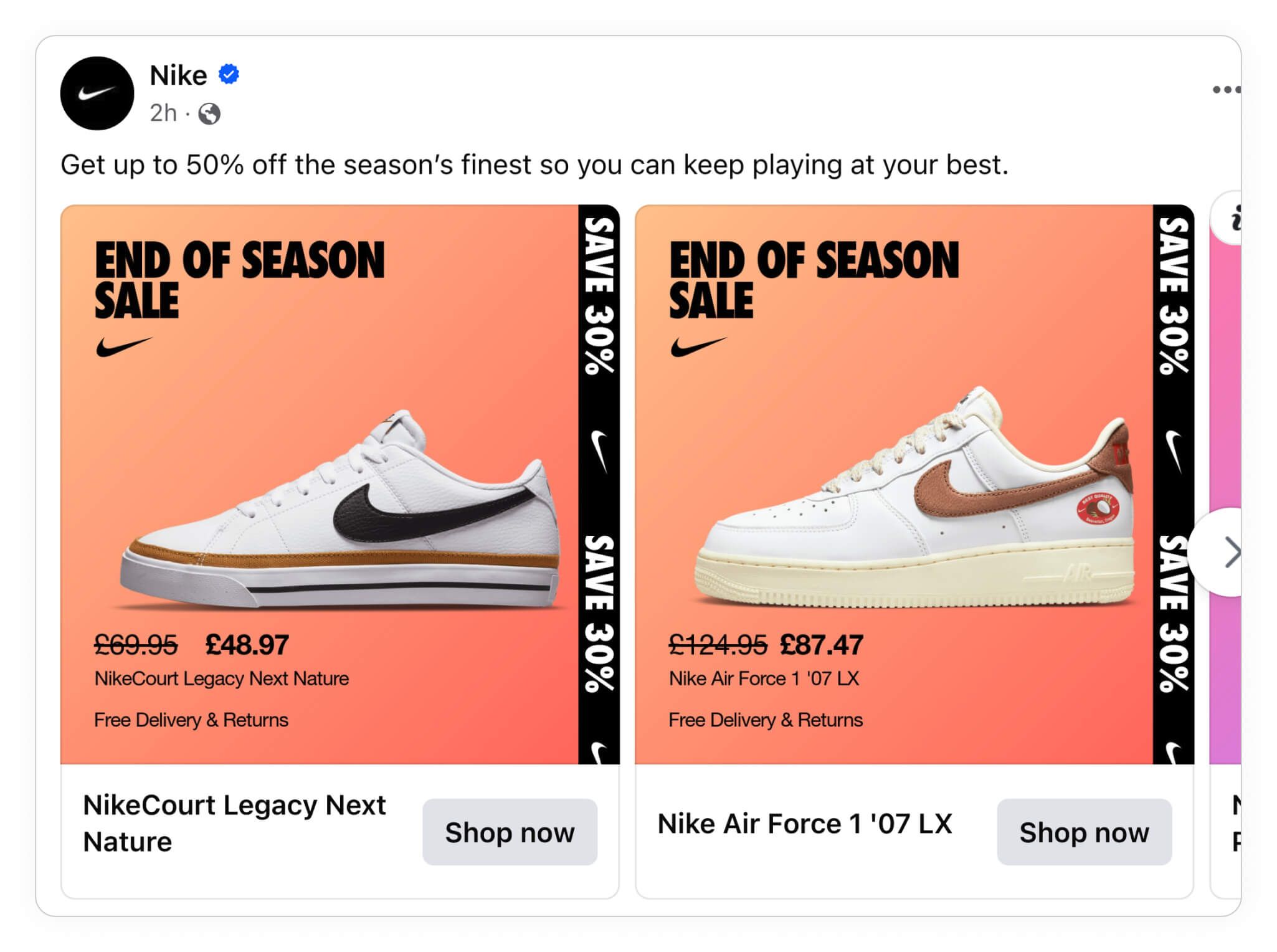
Here's how showing savings on average influence Catalog Ads:
Return On Ad Spend
+73%
Cost Per Purchase
-13%
Click Through Rate
-2%
Cost Per Click
-11%
Conversion Rate
+9%
Usage
22%
These numbers show how Catalog Ads showing savings perform on average compared to Catalog Ads not showing savings.
Remember that these are average numbers. For some brands, savings perform better, and for other brands, savings perform worse.
Prominent discount messaging creates a sense of urgency (especially with phrases like “limited time only”). This motivates quicker purchase decisions which explains the increase in conversion.
After all, mid-end brands’ customers remain price-sensitive. Displaying savings and discounts signals that they’re still getting a deal, even if the products are priced higher than budget brands.
You can learn more about showing savings during campaigns in your Catalog Ads right here and see a lot of sales and campaign Catalog Ad examples here.
Showing Dates in your Catalog Ads
Dates shown on catalog ads typically indicate a short, limited-time promotion. By nature, this adds urgency.
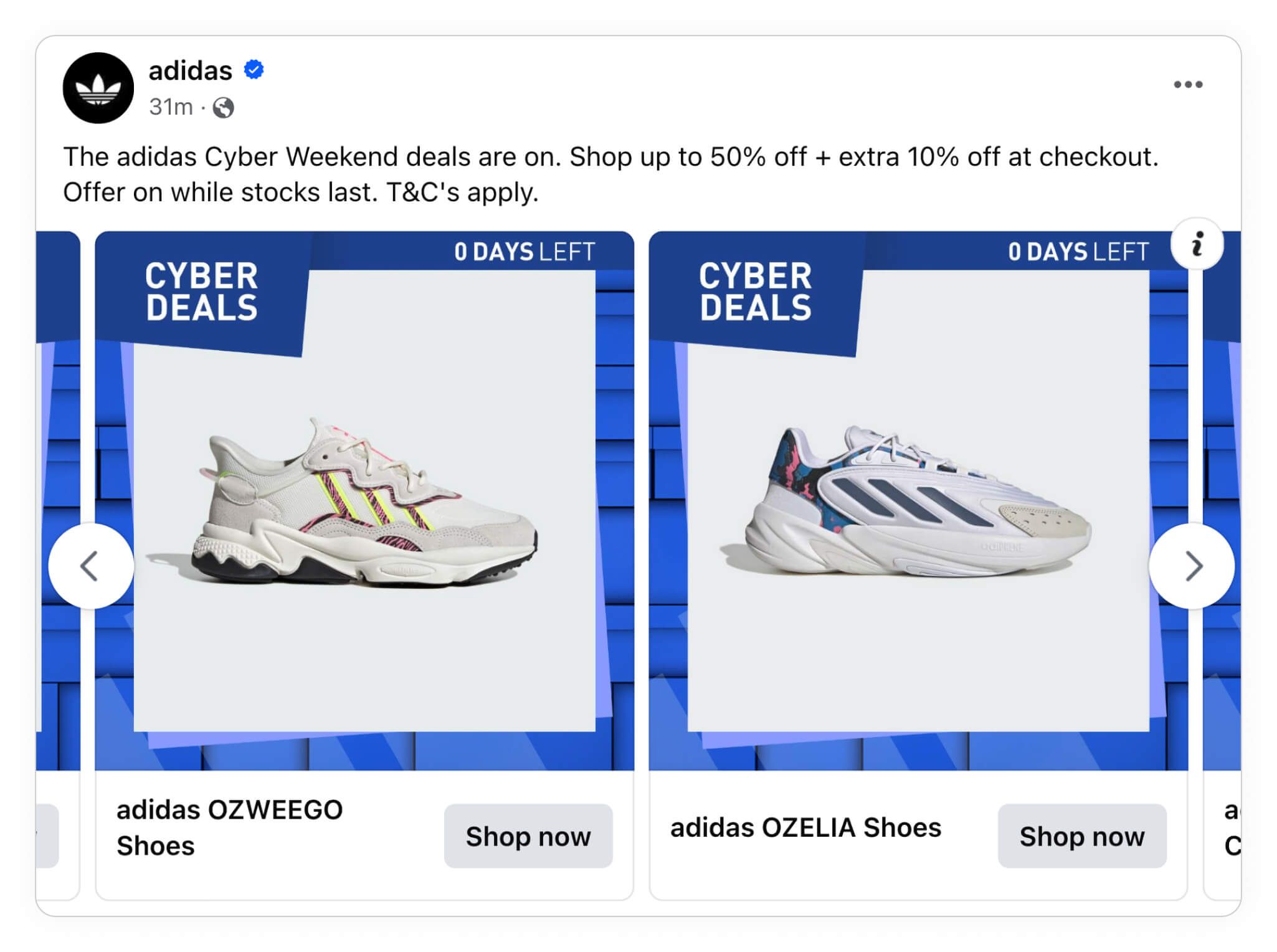
Is this urgency beneficial for mid-range brands? Let's look at some data.
Here's how showing dates on average influence Catalog Ads:
Return On Ad Spend
+21%
Cost Per Purchase
-20%
Click Through Rate
-4%
Cost Per Click
+14%
Conversion Rate
+15%
Usage
20%
These numbers show how Catalog Ads showing dates perform on average compared to Catalog Ads not showing dates.
Remember that these are average numbers. For some brands, dates perform better, and for other brands, dates perform worse.
The 15% increase in conversion rate is likely explained by the fact that it creates a sense of urgency, especially when it includes an end date for a sale. Your target audience is more likely to proceed to checkout when they know a deal is time-limited.
For mid-end brands that depend on repeat business, a date range also helps build credibility.
Highlighting News in your Catalog Ads
Incorporating the word “new” to draw attention to new arrivals, for example, deliver a mixed bag of results for mid-end brands. You can expect your cost per click to be slashed by 26%. However, all that gains will be lost as your conversion rate will plummet by the same percentage.
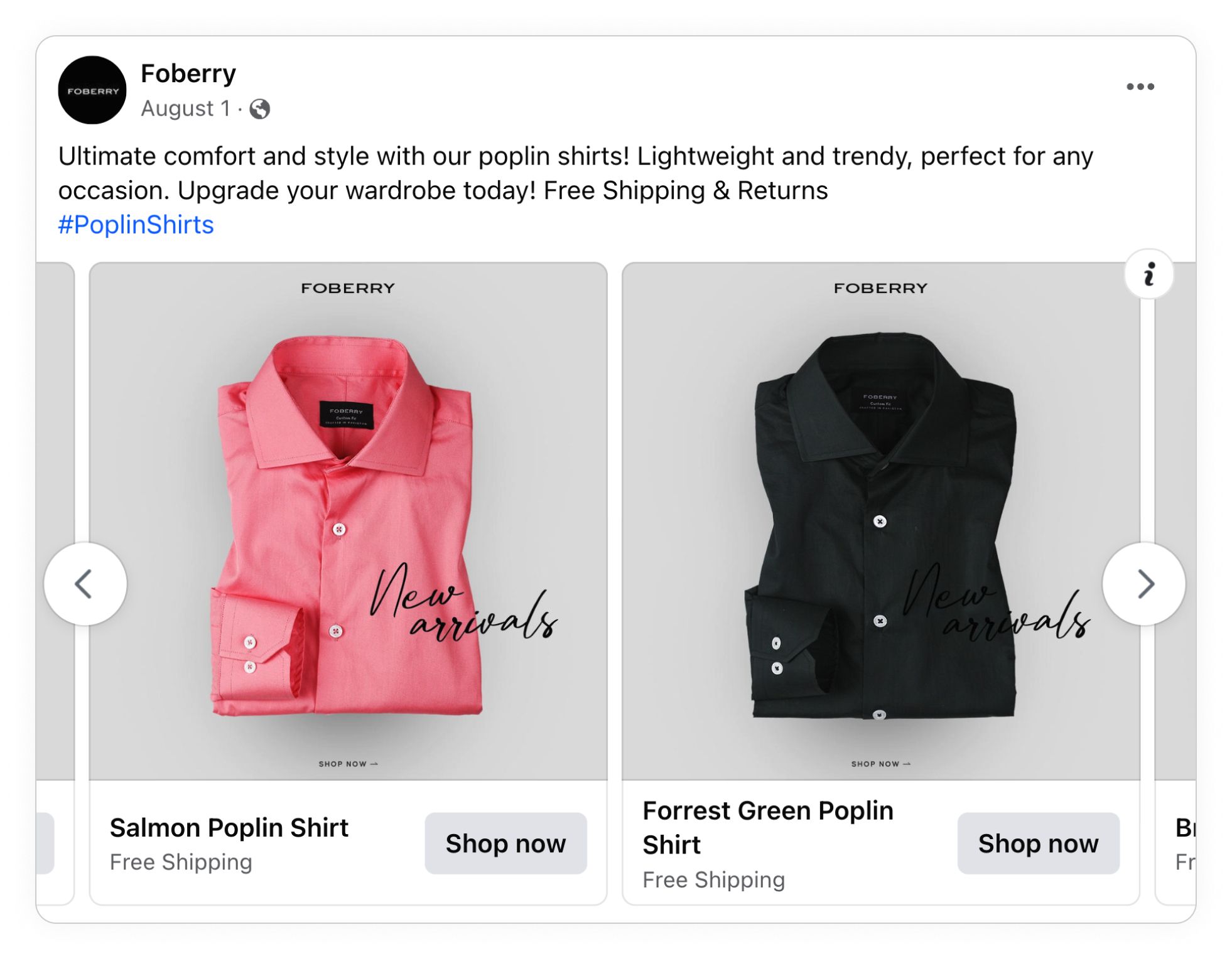
Here's how highlighting news on average influence Catalog Ads:
Return On Ad Spend
-7%
Cost Per Purchase
-12%
Click Through Rate
+3%
Cost Per Click
-26%
Conversion Rate
-26%
Usage
21%
These numbers show how Catalog Ads highlighting news perform on average compared to Catalog Ads not highlighting news.
Remember that these are average numbers. For some brands, highlighting news perform better, and for other brands, highlighting news perform worse.
In many cases, it’s the proven and popular products that are the core revenue drivers for mid-end brands. Plus, if your customers are used to seeing products on promotion, they might be confused when they see a new product sold at its full price.
Showing Shipping info in your Catalog Ads
Shipping ( delivery) information in catalog ads refers to details provided about how and when, and where a product will be delivered, such as delivery timeframes, costs, and available shipping methods.
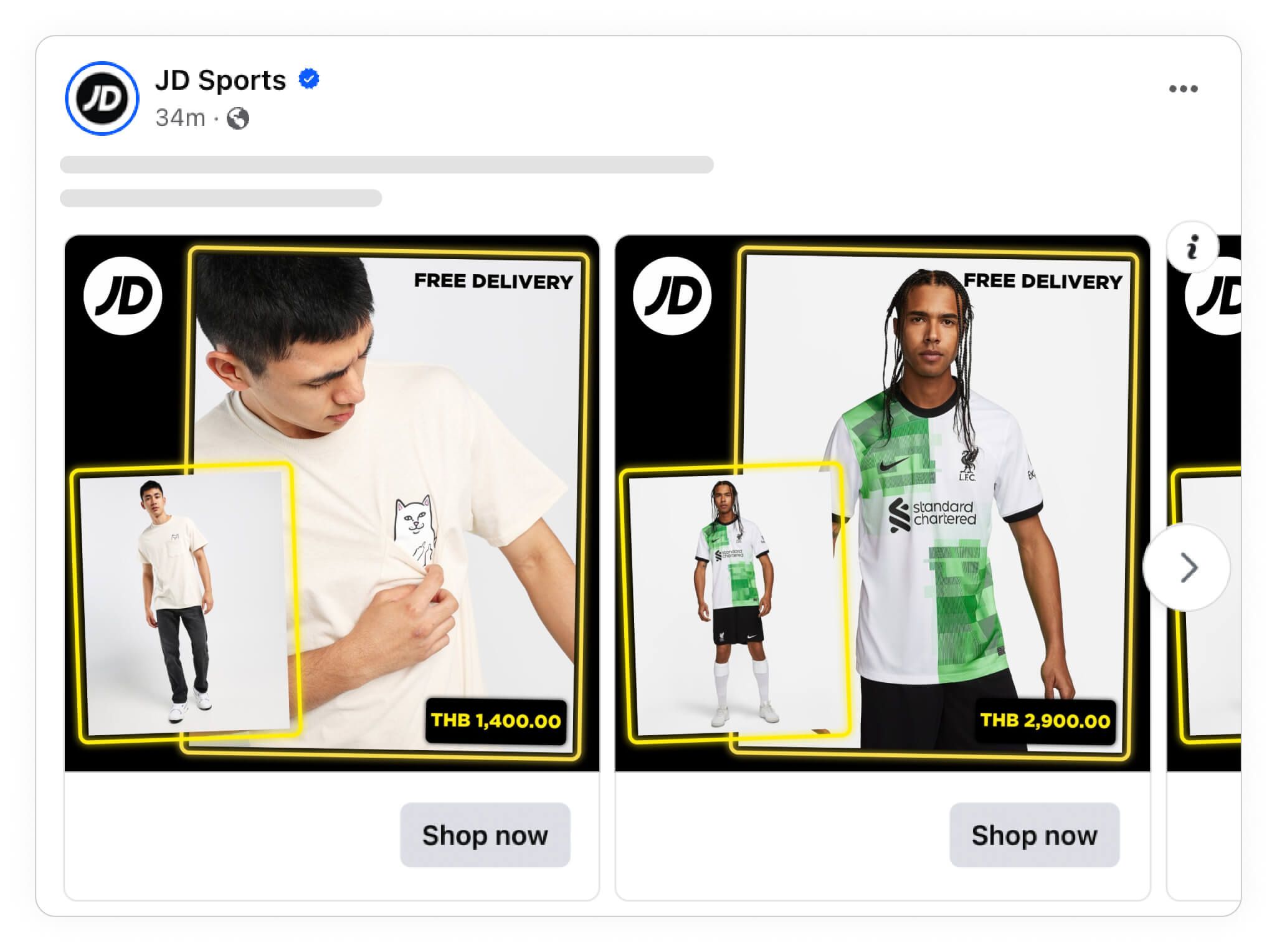
Depending on timing and buyer segments, this can be valuable information to display in your catalog ads, but before we glorify it let's see what our insights reveal.
Here's how showing shipping info on average influence Catalog Ads:
Return On Ad Spend
-8%
Cost Per Purchase
-24%
Click Through Rate
+1%
Cost Per Click
-28%
Conversion Rate
-17%
Usage
19%
These numbers show how Catalog Ads showing shipping information perform on average compared to Catalog Ads not showing shipping information.
Remember that these are average numbers. For some brands, shipping info perform better, and for other brands, shipping info perform worse.
These results underscore that shipping information is best shared on the product or checkout page or in a follow-up email. You need more space than Catalog Ads can offer to answer questions about matters like timelines or locations.
For customers who are browsing casually, shipping details aren’t a primary concern. Compelling product information or promotional messaging like a saving or discount are details that will encourage them to click (hence, why it has a miniscule impact on the CTR).
That said, shipping is often a key concern for the mid-end segments. By addressing it directly in your Catalog Ads, you can make your ad more aligned with user intent. This can improve your ad placement, which is seen in the reduced CPC.
Using Product Assets in your Catalog Ads
The benefit of product assets is that you can use it to show other key information like ratings or brand logos visually. Visual cues are much easier to digest than text which explains product assets’ effectiveness across all key metrics.
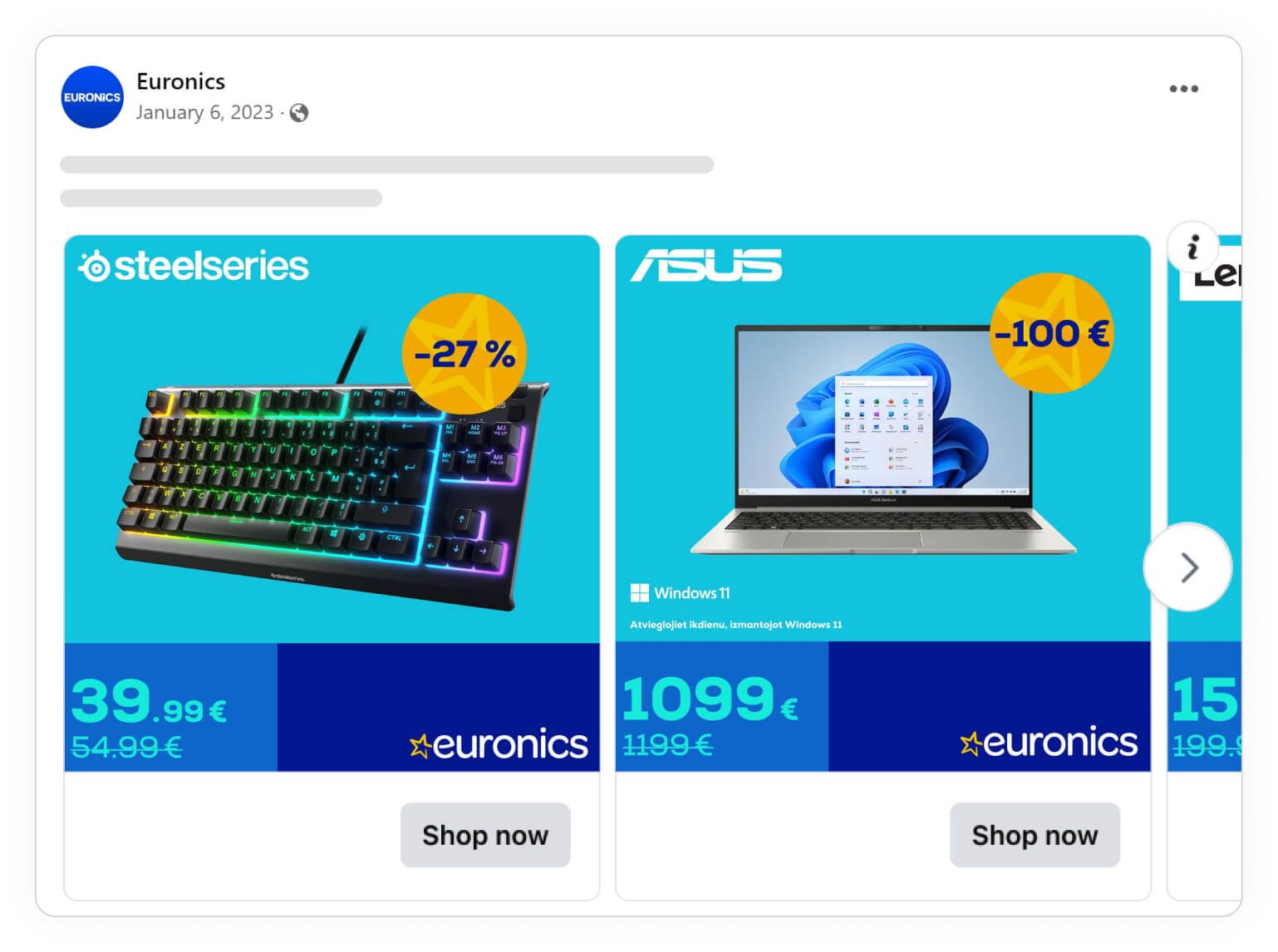
Product Assets are especially effective for mid-end shops that don't rely on luxury products or very affordable products.
- Affordable shops see a +12% improvement in Return on Ad Spend when showing Product Assets
- Mid-end shops see a +75% improvement in Return on Ad Spend when showing Product Assets
- High-end/ Luxury shops see a -17% decline in Return on Ad Spend on average when showing Product Assets
Here's how showing product assets on average influence Catalog Ads:
Return On Ad Spend
+75%
Cost Per Purchase
-34%
Click Through Rate
+6%
Cost Per Click
-5%
Conversion Rate
+4%
Usage
14%
These numbers show how Catalog Ads showing product assets perform on average compared to Catalog Ads not showing product assets.
Remember that these are average numbers. For some brands, product assets perform better, and for other brands, product assets perform worse.
With Confect, any information shared on your website can become a product asset. You can learn more about using Product Assets in your Catalog Ads here.
Showing Social Proof in your Catalog Ads
As humans, we often form our opinions and perceptions based on the actions of others. If people bought it, praised it, and left great reviews - it must be a good product, right?
That, ladies and gentlemen, is the power of social proof, and when used in catalog ad design, it can do wonders.
The lower price levels you have compared to competitors, the better showing Social Proof will typically perform.
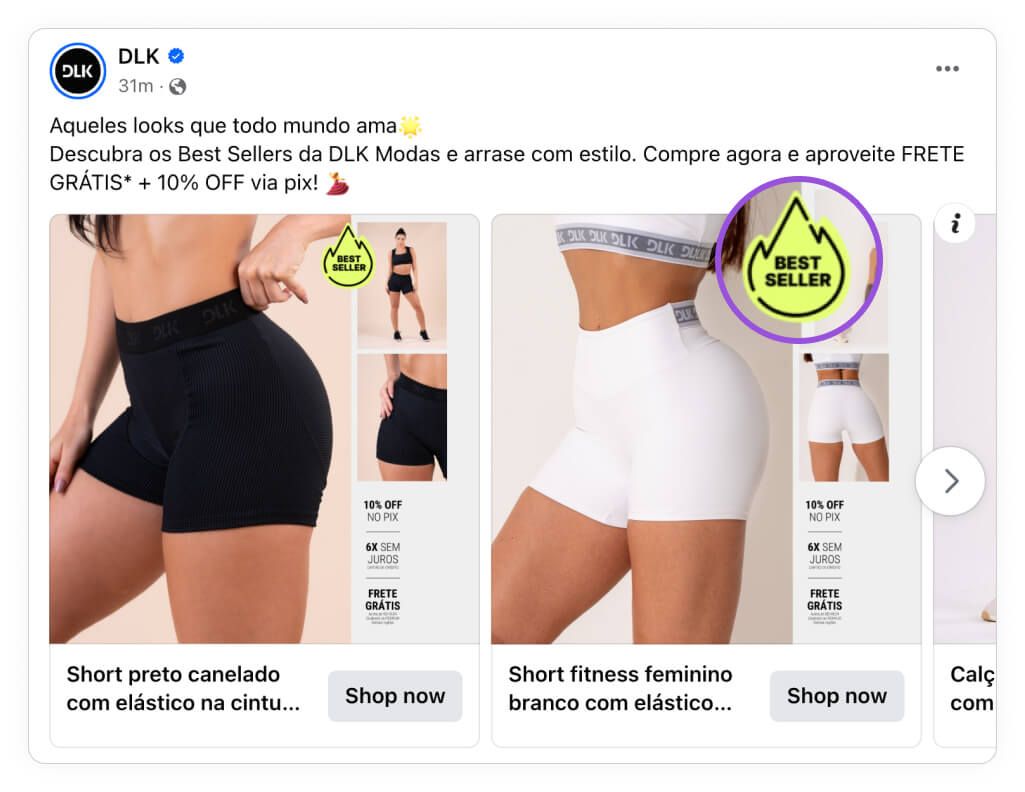
We can see that, the lower price levels you have compared to competitors, the better showing social proof will typically perform. Here’s the ROAS change you can expect:
- Affordable shops see a +72% improvement in Return on Ad Spend when showing Social proof
- Mid-end shops see a +32% improvement in Return on Ad Spend when showing Social Proof
- High-end/ Luxury shops see a +10% improvement in Return on Ad Spend when showing Social Proof
Here's how showing social proof on average influence Catalog Ads:
Return On Ad Spend
+32%
Cost Per Purchase
-15%
Click Through Rate
-14%
Cost Per Click
+23%
Conversion Rate
+47%
Usage
9%
These numbers show how Catalog Ads showing social proof perform on average compared to Catalog Ads not showing social proof.
Remember that these are average numbers. For some brands, social proof perform better, and for other brands, social proof perform worse.
Insert table with different percentages here
Mid-end brands can’t just compete on price. Quality is also important. Social proof like “customer favourite” or “4.8 stars from 1,100 reviews” improves the product’s perceived quality.
It also has a positive impact on the brand itself. Highlighting that real people trust and buy their products will help mid-end brands to grow their recognition and credibility.
You can learn more about showing Social Proof in Catalog Ads here.
Showing Product Brands in your Catalog Ads
The more high-end and expensive your products are, the better performance you will typically see when showing the brands of your products.
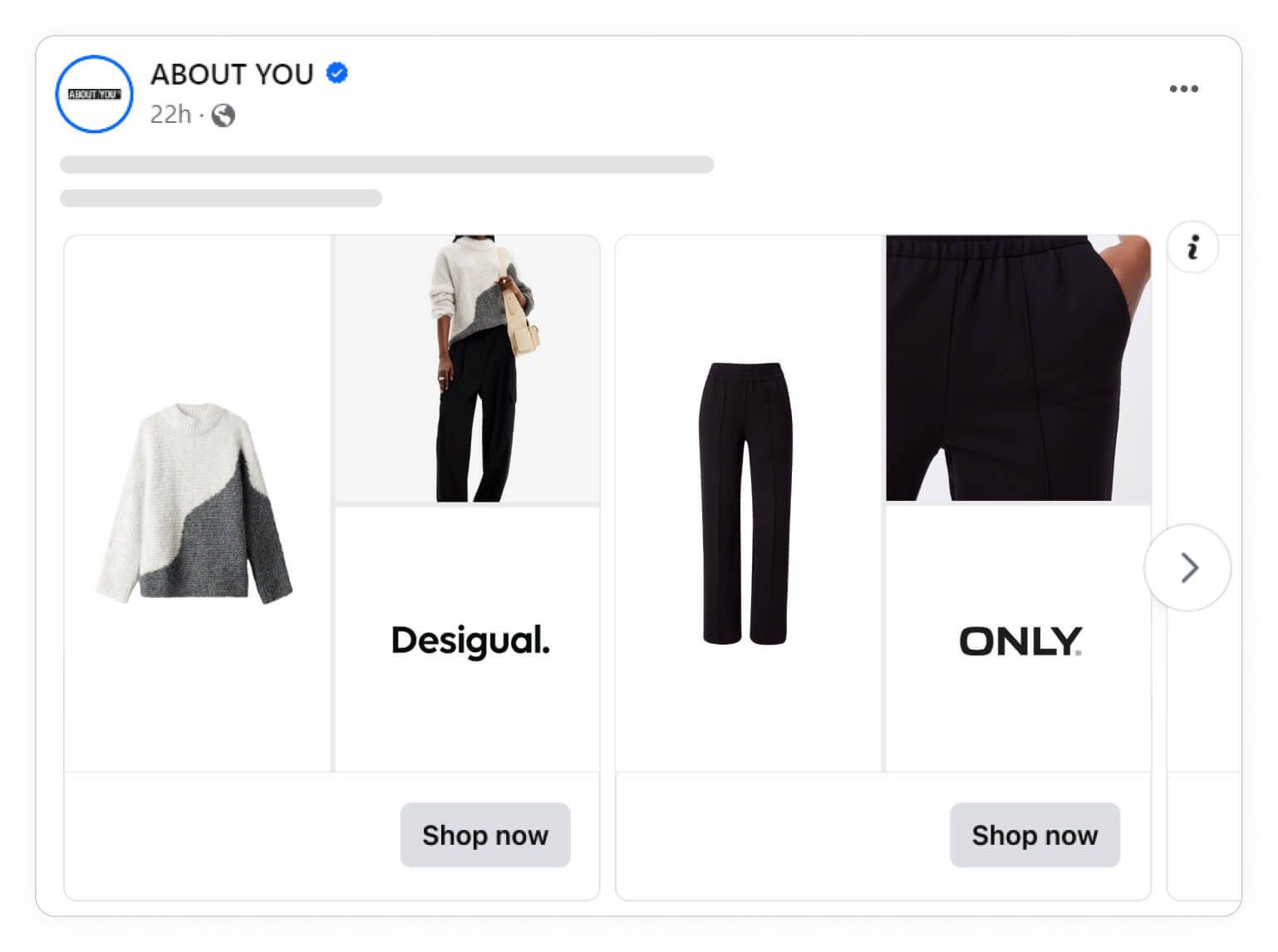
When it comes to displaying product brands, the reverse is true. Now, it’s not a matter of the lower the price, the better the performance. Instead, the more high-end and expensive your products are, the better performance you will typically see when showing the brands of your products.
- Affordable shops see a +13% improvement in Return on Ad Spend when showing brands
- Mid-end shops see a +29% improvement in Return on Ad Spend when showing brands
- High-end/ Luxury shops see a +62% improvement in Return on Ad Spend when showing brands
Here's how showing brand names on average influence Catalog Ads:
Return On Ad Spend
+29%
Cost Per Purchase
-9%
Click Through Rate
+16%
Cost Per Click
-11%
Conversion Rate
-3%
Usage
6%
These numbers show how Catalog Ads showing brand names perform on average compared to Catalog Ads not showing brand names.
Remember that these are average numbers. For some retailers, brand names perform better, and for other retailers, brand names perform worse.
Showing the brand name helps separate your offerings from generic or low-cost alternatives. It lets shoppers know they’re not just buying a cheap item, but that they’re buying from a brand with an identity, standards, and credibility.
You can learn more about showing brand names or brand logos in your Catalog Ads here.
Showing Custom_labels in your Catalog Ads
If you want to really show why your product is special and valuable, you'll likely use custom labels. They are perfect for displaying product details that matter to your customers, such as sizing, material, origin, product specs, and many other unique selling points your product feed holds.
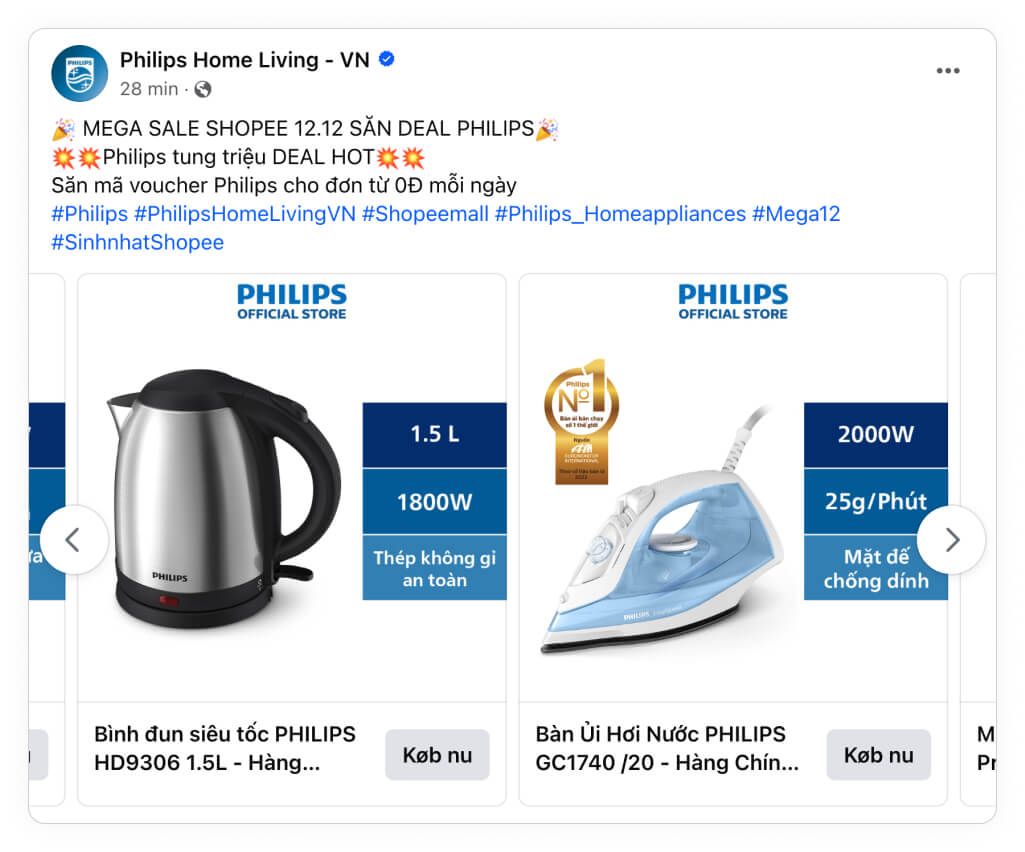
Here's how showing custom labels on average influence Catalog Ads:
Return On Ad Spend
+37%
Cost Per Purchase
-17%
Click Through Rate
-16%
Cost Per Click
-24%
Conversion Rate
+13%
Usage
9%
These numbers show how Catalog Ads showing custom labels perform on average compared to Catalog Ads not showing custom labels.
Remember that these are average numbers. For some brands, custom labels perform better, and for other brands, custom labels perform worse.
If you’re more concerned about improving the ROAS than the CTR, this can be a good strategy. Instead of relying only on discounts, labels like “Customer Favourite” or “Sustainably Made” elevate a product’s perceived value.
In short, it lets you use your limited ad space optimally by using attributes other than price to communicate value. This is especially important for mid-end brands as they compete on more than just cost.
Showing Categories in your Catalog Ads
Categories (or product sets, if you love working in Meta Ads Manager) are a great way to split and highlight specific products. For example, if you're selling clothes, your categories could be jeans, shirts, hoodies, etc.
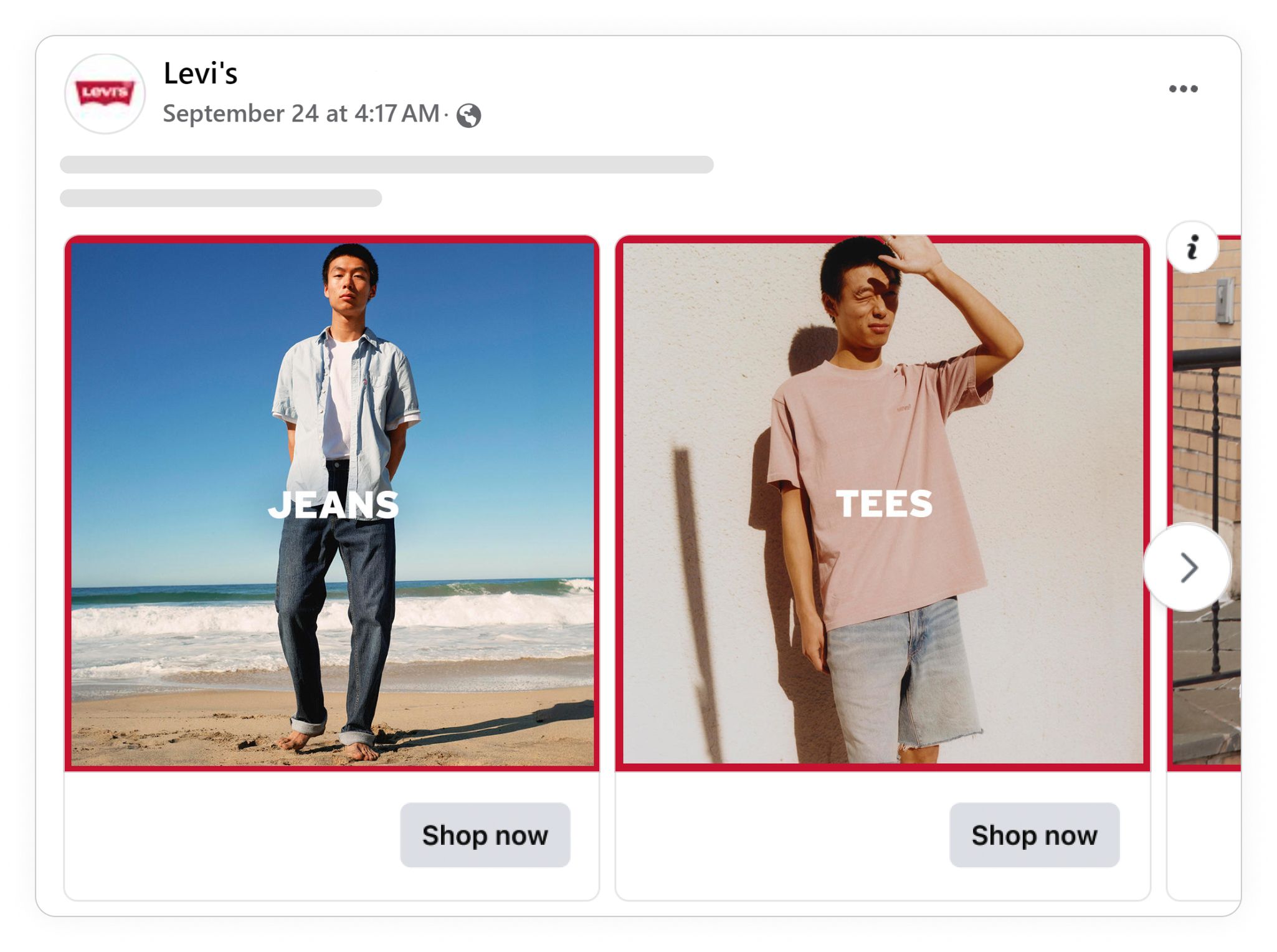
Here's how showing product categories on average influence Catalog Ads:
Return On Ad Spend
+167%
Cost Per Purchase
-33%
Click Through Rate
-16%
Cost Per Click
+35%
Conversion Rate
+204%
Usage
2%
These numbers show how Catalog Ads showing categories perform on average compared to Catalog Ads not showing categories.
Remember that these are average numbers. For some brands, categories perform better, and for other brands, categories perform worse.
These numbers clearly show that of all the strategies including categories in your Catalog Ads is the best approach. The fact that it has the potential to increase your ROAS by a massive 167% and your conversion rate by more than 200% will make you forgive the slight drop in CTR.
You can use categories to spotlight specific categories like seasonal favourites or clearance items. This way, you can guide users toward conversion-friendly sections of your catalog.
What’s more, categories help encourage cross-selling by showcasing the full range of your brand's offerings. This is key for mid-end brands as they often operate with tighter margins than premium brands and need to find creative ways to achieve higher order values without acquiring new customers.
Showing Product Descriptions in Catalog Ads
Product description, although valuable information, should it be shown on your catalog ads? Let’s clear the fog with some data.
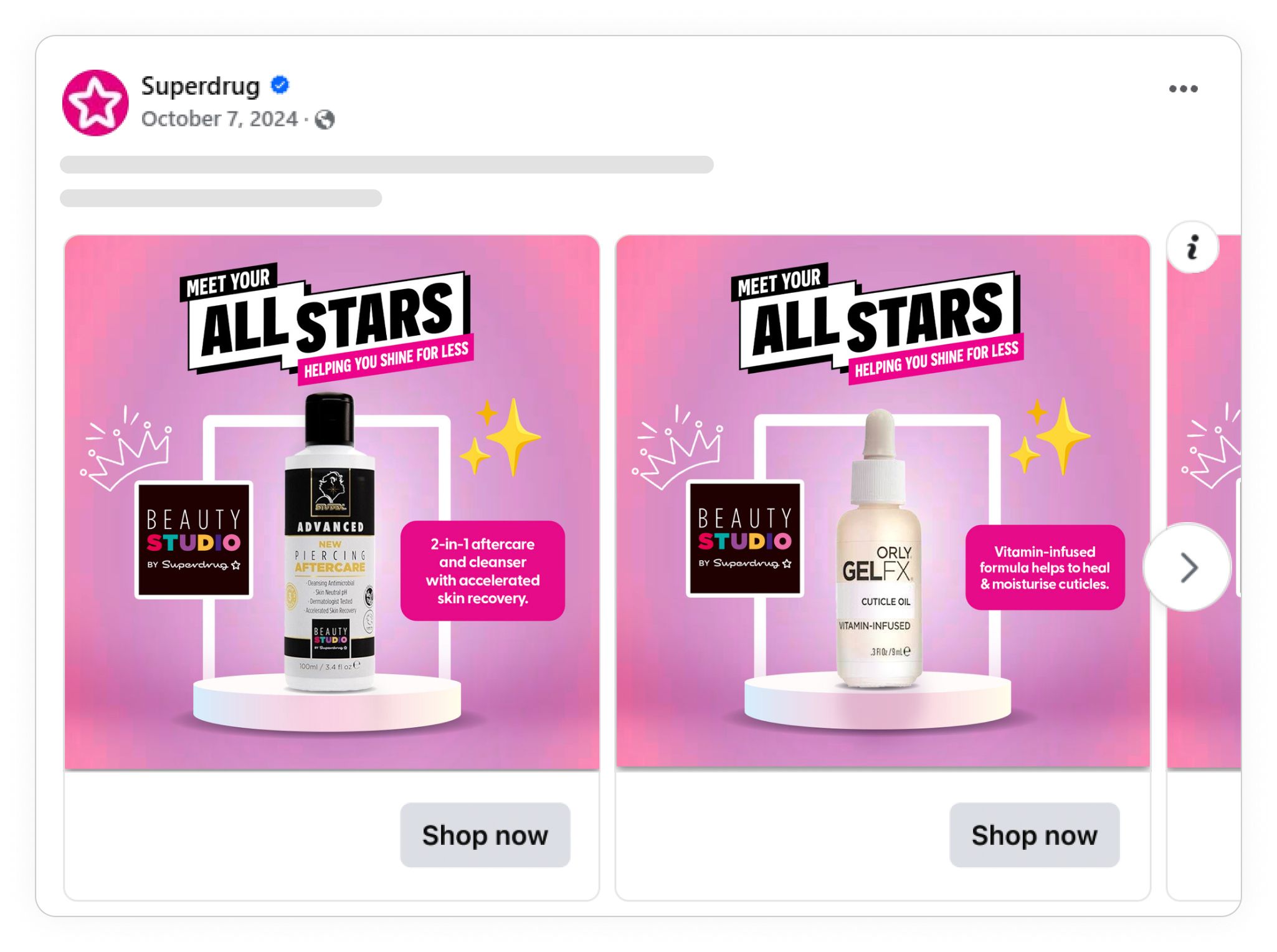
Here's how showing descriptions on average influence Catalog Ads:
Return On Ad Spend
+7%
Cost Per Purchase
+91%
Click Through Rate
-46%
Cost Per Click
+61%
Conversion Rate
-34%
Usage
0%
These numbers show how Catalog Ads showing descriptions perform on average compared to Catalog Ads not showing descriptions.
Remember that these are average numbers. For some brands, descriptions perform better, and for other brands, descriptions perform worse.
As these numbers show, including product descriptions in your ads doesn’t make sense for mid-end brands. After all, effective ads use a clean layout. Text-heavy elements like product descriptions will add unnecessary clutter to the design.
Also, detailed descriptions might attract users who aren't in the purchase-ready mindset yet and simply want to read more. This can explain the higher CPC and lower conversion rate.
Instead of cramming all the product details into the ad, you can drive users to a dedicated product page on your website where they can read in-depth descriptions. After all, information like social proof does a far better job of communicating value that helps mid-end brands to drive sales.
Final thoughts
Of all the elements, categories appear to be the most valuable for mid-end brands. Plus, considering that it’s one of the rarely used fields in Catalog Ads designs, including this information will place your advertising efforts in another category that competitors will find hard to beat.
Combine that with elements like on-sale designs that highlight savings or discounts (without necessarily including the original price) and you might just have a winning formula. While mid-end brands’ typical customer might have more spending power, they’re still not willing to give all that power to luxury stores. They value brands that highlight value and, based on all this data, Catalog Ads are a valuable marketing channel to do just that.
Bookmark this page by pressing ctrl + D / cmd + D, or by clicking the star icon in your URL bar ⭐️.
